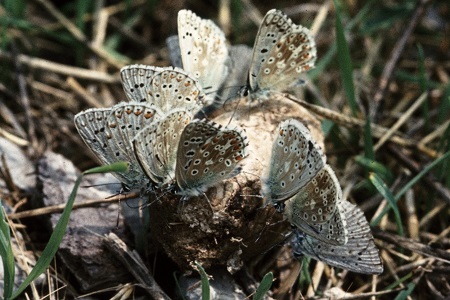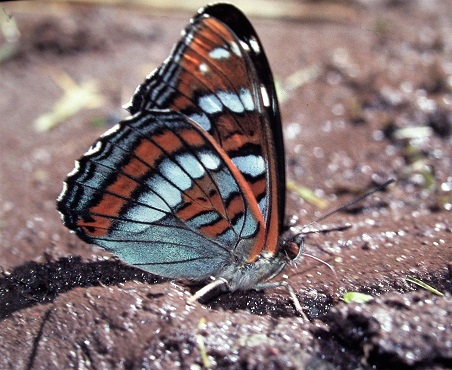|
11. Search for food
Butterflies search for both liquids rich in energy for their own consumption and for places where the larval food-plant, rich in protein, grows. Larvae are herbivores, usually specialised for eating leaves of particular plant species or their buds or fruits.
If suitable flowers for the butterfly and the right host plant for the larva are present, then the butterfly species may be present but this not always the case. The first thing to consider is the quantity and quality of the food. How many food sources should be present so that a population has a chance to survive? This is quite easy to estimate when the larva is monophagous, when it is oligophagous it is less easy and when the larva is polyphagous it becomes very difficult. However, polyphagous can be misleading because the larvae may be specialised in eating flower buds or fruits.
Adult butterfly
The adult butterfly needs energy for flying, usually using liquids with a high sugar content. Also a daily water uptake is important to prevent desiccation. Butterflies have the reputation of being flower visitors but in reality they use various kinds of food, even dry excrements. With dry material a butterfly has to add some liquid first, through its proboscis or anus to dissolve the minerals before it is able to drink it through its proboscis. The length of the proboscis determines from what kind of flowers the nectar will be within reach. There are species with a very long proboscis, longer than the body length as in the large skipper (Ochlodes sylvanus), and others with short ones; the latter, for example the brown hairstreak (Thecla betulae), can only use liquids such as honeydew on leaves.
| |
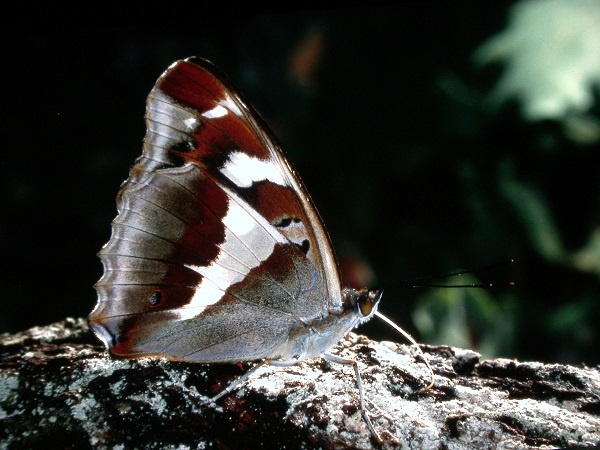 Apatura iris, feeding on rotten mushroom. Photograph: Frits Bink ©. Apatura iris, feeding on rotten mushroom. Photograph: Frits Bink ©. |
|
|
The connection between a large amount of flowers and many butterflies flying around is very weak.
More important is the chance meeting between a butterfly and a nectar source; so it is the distribution of flowers rather than quantity which is important. Although the clouds of butterflies on a blooming field of alfalfa (Medicago sativa) may give an opposite impression. Another food source for some butterflies is rotten fruit and for some even rotten mushrooms or small corpses.
Butterflies can also store food in fat cells of their abdomen, especially species that migrate or hibernate. They remain for some time on a food source while drinking the whole day in the warm sunshine, during which their abdomen will swell considerably. The buddleia (Buddleja davidii) has an ideal flower spike for such lazy drinkers.
|
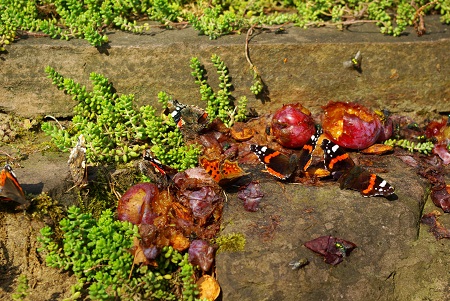 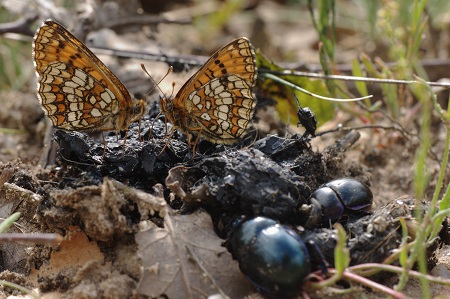 |
|
Vanessa atalanta, feeding on rotten fruit. Photograph (left): Frits Bink ©.
Adult butterflies can feed only on liquids because of the construction of their mouthparts, the proboscis. Most butterflies feed on liquids containing sugar, such as the nectar of flowers; however many prefer rotten fruit. It is well known that the red admiral (Vanessa atalanta) changes its food source from flowers to rotten fruit in the autumn. There are also lovers of rotten material containing proteins or minerals. Most of them will switch between sugar and protein as their nutritional requirements change; however, a few species feed exclusively on rotten material or detritus.
Melitaea athalia, feeding on excrements. Photograph (right): Jeroen Voogd ©. |
|
Polyommatus coridon, feeding on excrements.
Photograph (left): Frits Bink ©.
The heath fritillary (Melitaea athalia) is in most cases, a nectar feeder but sometimes also takes liquid excrement, the same applies to the chalk-hill blue (Polyommatus coridon).
A few species are exclusively protein feeders; the adult can be tempted by rotten cheese or by sprinkling diluted ammonia.
This is the well-known method of enticing
the purple emperor (Apatura iris) and the poplar admiral (Limenitis populi) from the
tops of trees, so they can be viewed at close quarters.
Limenitis populi, coming down from the top of a tree to drink.
Photograph (right): Frits Bink ©. |
|
Larva
The caterpillar needs protein rich food to grow. The quality of the food depends on the protein content and the digestibility. These parameters vary during the course of the season. The larvae of a species that hibernates as an egg hatching in early spring have very young leaves of high food quality available. The hairstreaks (Theclinae), for example, have eggs which hatch usually before bud burst are the famous example. Larva of these species hatching later in the season will die because they fresh hatched larva is not able to eat mature leaves.
When these species have more than one brood per year and the young larva can only utilise fresh growth, then the butterfly has to look for a locality where the food plant has a regrowth. This happens in the case of the small tortoise shell (Aglais urticae), of which the larvae feed on stinging nettle (Urtica dioica); in spring there is plenty of food, in summer only where the nettles have been cut down and started to regrow.
Butterflies having more than one brood per year may change larval food-plants. An example is the large white (Pieris brassicae): in spring it utilises large crucifers like garlic mustard (Alliaria petiolata), in summer sand rocket (Diplotaxis muralis) and cabbage (Brassica oleracea cultivars) in gardens.
There are cases where the larva appears to be polyphagous but this relates to some chemical substances which are the same in the different plant species. An example is the heath fritillary (Melitaea athalia) of which the larvae can live on ribwort plantain (Plantago lanceolata), cow-wheat (Melampyrum pratense), spiked speedwell (Veronica spicata), germander speedwell (V. chamaedrys) and foxglove (Digitalis purpurea). All these plant species contain the poisonous iridoid glycosides which stimulate the larvae to eat the leaves and which protect the larvae to some extend against diseases. (Van Genderen & Schoonhoven, 1996)
Grass eaters
The relation between grass-eating caterpillars and their food needs closer examination. There is no butterfly species of which the larvae are bound to a particular grass or sedge. On the other hand there are only a few grass species which are refused as food by butterfly larvae, so in general it does not matter what species of grass is present.
But many secondary factors determine to some degree the strength of the relationship between butterfly species and grass species. These are vegetation structure, microclimate, soil fertility and disturbance. The latter is caused mainly by haymaking and cattle grazing.
Own experiments produced figures about the acceptance of different grass species by the small heath (Coenonympha pamphilus) and the wall (Lasiommata megera). Twenty two different potted grasses were tested. Of the larvae which were put on these grasses their choices of grass species was observed and their growth rate measured. The pupae were weighed immediately after pupation (Soontiëns & Bink, 1997).
Two grass species turned out to be the least edible: wavy hair grass (Deschampsia flexuosa) and common quacking grass (Briza media). Creeping bent (Agrostis stolonifera) was also refused under these rearing conditions. Wavy hair grass is preferred by cattle in wintertime and also the noctuid moth (Cerapteryx graminis), which overwinters as an egg, prefers this grass. It is one of few grasses which grow during wintertime. On the other hand the related species Deschampsia cespitosa is refused by cattle because of its stiff leaves. Butterfly larvae accept this grass very well and it is recommended in breeding experiments on vulnerable species. Also some other grasses were preferred; surprisingly ryegrass (Lolium perenne), which has a bad reputation due to its extensive use in growing beef cattle to make artificial meadows free of butterflies.
Purple moor-grass (Molinia caerulea) revealed the seasonal fluctuation in food quality. This grass grows fast in late spring and is accepted by cattle and butterfly larvae; however, in summer the food quality declines even when fertiliser is added, its seasonal growing cycle persists, the grass shrivels up completely and retract essential minerals into the roots. Its food quality was tested on the wall: in early summer the larvae grew very well but in late summer the second brood suffered from the decline in the grass’ quality. A high proportion entered hibernation and the larvae which did continue development had a lower pupal weight. This grass species is unsuitable for the development of a double brooded species, although in the spring period it is a very good food source. The seasonal cycle of purple moor-grass is shifted a little by growing conditions; on moist and fertile soil growth starts earlier in spring and continues later in season. In the former situation this grass is a very good host-plant for the large skipper (Ochlodes sylvanus), whereas on a poor dry soil this skipper is unable to complete its lifecycle on this grass.
Grass is an important food source for butterfly larvae, up to a quarter of the species depend upon it. In the Benelux seven species of skippers (Hesperiinae) and nineteen species of browns (Satyrinae) are grass eaters. Females select a grass species visually. Butterflies which prefers open landscape and short vegetation will recognize sheep’s fescue (Festuca ovina s.l.), red fescue (Festuca rubra) and crested dogs’tail (Corynephorus canescens) easily as small tussocks in sparse vegetation. In the case of skippers, of which the larvae live in curled leaf, their cradle, broad leaved grass species are selected. These type of grasses grow on rather fertile soil along a wood or shrub edge.
In the Benelux there are 120 species in the family of grasses (Poaceae). Furthermore, there are several species of sedges (Cyperaceae), of which there are 80, which are also very good host-plants. To study the host-plants of grass feeding skippers and browns takes a lot of time, but in practise only the knowledge of the common species is necessary. These species are listed and arranged in the appendix 2‘Common grasses’.
Appendix 2. Common grasses
|



 JV.jpg)


